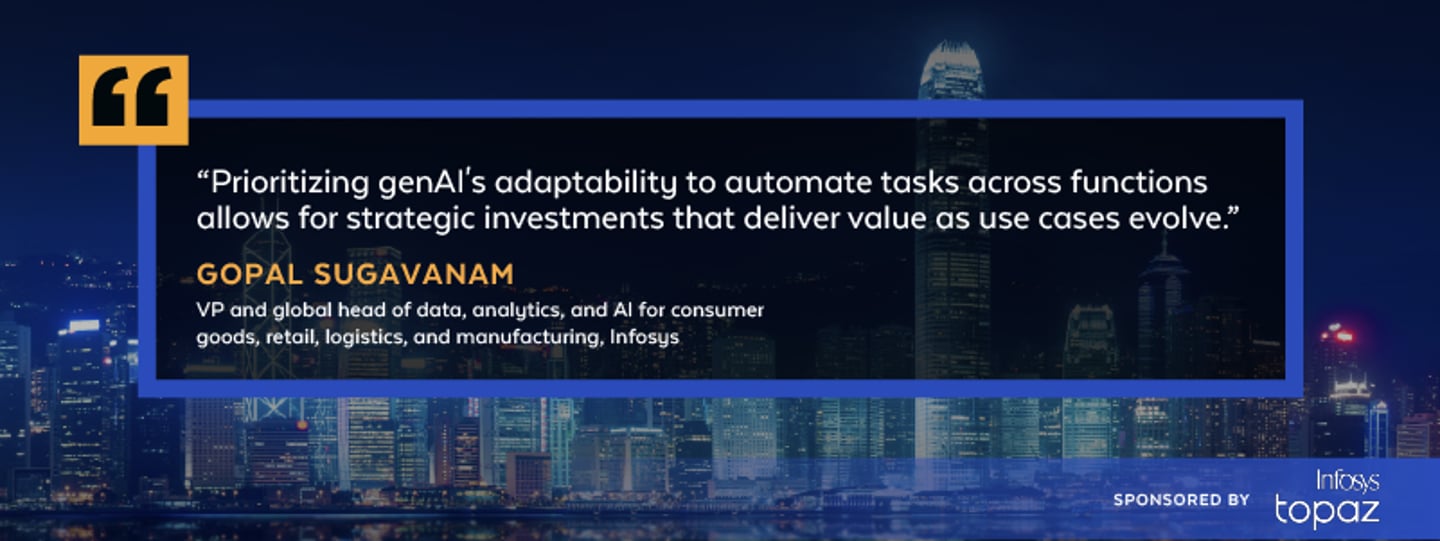Building Smart and Scalable Generative AI Business Cases
Developing a robust and sustainable generative AI strategy is a complex, multi-faceted ambition. As consumer goods leaders work to leverage the new technology in ways that support their competitive advantage, there are a host of considerations that should be evaluated.
In this Q&A, Gopal Sugavanam, VP and global head of data, analytics and AI for consumer goods, retail, logistics, and manufacturing at Infosys, details key factors in building a business case, how to measure ROI, gaining stakeholder buy-in, and the value of partnerships.
CGT: What are some key factors to consider when building a business case for investing in generative AI tools?
Gopal Sugavanam: Building a strong business case for generative AI requires a holistic approach that not only considers the business impact of the genAI capability but also the technical feasibility assessment and the adoption likelihood assessment of the genAI capability being considered.
- Identify a specific problem it can solve like demand sensing, scenario planning and risk management, resource allocation optimization, etc. in the CPG industry or personalizing product recommendations in retail.
- Quantify potential benefits and determine the relevant value drivers and business metrics to track the benefits — for example, increased customer satisfaction associated with target NPS scores.
- Address costs holistically. Enterprises must comprehensively address one time and recurring CapEx and OpEx costs across people, vendors, software, infrastructure, and data requirements.
- Assess the technical feasibility of implementing the genAI capability. Assess the data readiness, AI foundation readiness and implementation complexity to ensure the feasibility of implementing the genAI capability is proactively taken into consideration
- Assess the probability of end user adoption. Take into account relevant training, change management and ongoing maintenance requirements to ensure adoption by the end users of the capability
- Generative AI demands a new breed of talent such as prompt engineers who bridge the programming and creative writing gap. Enterprises must consider this talent shift as another crucial factor when building their generative AI business case.
CGT: With use cases evolving so rapidly, how can companies better determine ROI?
Sugavanam: Yes, with use cases evolving so rapidly, traditional ROI calculations might not capture the full value of generative AI. However, companies can still make informed decisions.
Enterprises can start with proof-of-concept projects to showcase real-world impact by tracking process improvements and downstream benefits like increased sales. Enterprises must embrace qualitative improvements like employee productivity or customer satisfaction even if they take time to quantify. Prioritizing genAI's adaptability to automate tasks across functions allows for strategic investments that deliver value as use cases evolve. This iterative approach, with continuously refined ROI calculations, ensures businesses capture the full potential of genAI as it matures.
Consider one of our client's scenarios: Despite heavy investments in marketing, their current model failed to deliver significant business value or adapt to changing consumer needs. Recognizing the need for a data-driven and AI/genAI-first approach, we prioritized gaining comprehensive, real-time insights into their omnichannel operations.
This deeper customer understanding and fostering of marketing synergies allowed us to increase consumer reach and market share for our client. By starting small, gathering data, and adapting to changing needs, businesses can unlock the transformative potential of generative AI.
CGT: What’s your advice for leaders who need to win over skeptical stakeholders?
Sugavanam: Leaders can win over stakeholders by framing generative AI as a strategic advantage that augments human capabilities, not replaces them, while providing concrete success stories reinforcing value being released from similar companies in the industry. Here are some additional strategies to win over generative AI skeptics
Building trust in generative AI outputs is key. Explainable AI helps stakeholders understand why AI makes recommendations, fostering transparency and collaboration. This reduces the "black box" perception and allows for better risk management. Enterprises must address ethical concerns about data privacy and responsible use to build trust.
Redesign operating models to foster collaboration and optimize workflows early on, unlocks the full potential of AI's transformative impact on work.
Ensure a seamless user experience (UX) by designing generative AI interactions that blend naturally with existing user journeys.
Embrace experimentation and rapid iteration ("failing fast") to unlock Gen-AI's transformative potential. This agile approach allows businesses to learn quickly, optimize their AI strategies, and gain a competitive edge.
CGT: What are some considerations in choosing the right partners for these initiatives?
Sugavanam: Choosing the right AI partner is critical. Enterprises must look for partners with industry expertise and a proven track record with the company's specific use case. It's good to evaluate partners that follow robust data security practices and are committed to ethical AI development.
In-house deployment experience is valuable to understand partner capabilities. Additionally, enterprises must consider scalability and partner’s ongoing support to ensure the company's evolving needs are met.
Using AI effectively requires significant investment both in research and development and potentially in hiring specialized talent. Ideally, the partner should also have the ability to invest in R&D and help the company scale its AI initiatives by establishing a foundation for successful enterprise-wide adoption, built on the principles of ‘Responsible by Design’.
To illustrate a successful AI partnership, let's consider how we started off and collaborated with a F&B major. We started by co-creating a strategic vision aligned with enterprise priorities, defined a robust AI governance organization structure and associated processes and tools, then identified high impact use cases through functional analysis (demand management, revenue, etc.). Demos/POCs using Infosys Topaz’ Generative AI Suite within their environment showcased value across multiple functions (marketing, R&D, sales, legal, and HR) to identify a set of AI initiatives that when implemented will drive revenue growth, cost efficiencies and improve productivity to achieve their ambitious vision of doubling revenue as an AI-first enterprise.





